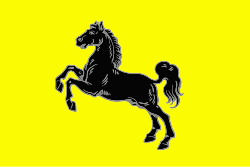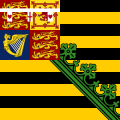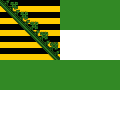 Flag of Landtag of Saxony.
Flag of Landtag of Saxony.
You can help expand this article with text translated from the corresponding article in German. (November 2022)Click [show] for important translation instructions.
|
 | |
| Landesflagge | |
| Use | Civil flag |
|---|---|
| Proportion | 3:5 (or 1:2) |
| Adopted | 1920, 1947, 1991 |
| Design | A bicolor of white over green. |
| Landesdienstflagge | |
 | |
| Use | State flag |
| Proportion | 3:5 (or 1:2) |
| Adopted | 1991 |
| Design | The civil flag with the addition of the coat of arms. |
Both the civil and state flag of the German state of Saxony feature a bicolour of white over green, similar to the Austrian province of Styria although they are historically not related to each other. The state flag is similar to the civil flag, except it is defaced in the centre with the coat of arms of Saxony. The colours of both flags were officially decided as state colours in 1815 [1] in the Kingdom of Saxony. The aristocracy used mostly and in first time the quadrangular version and later the rectangular.























